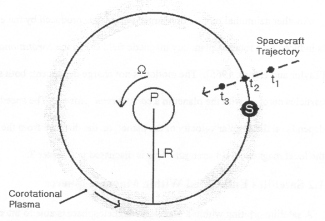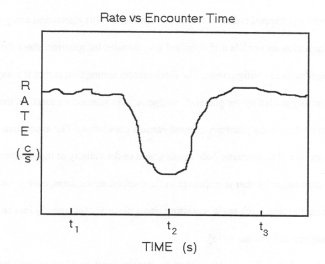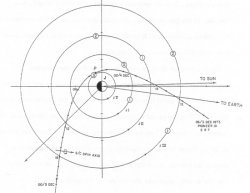Investigation of the Magnetosphere of Ganymede with Galileo's Energetic Particle Detector
Ph.D. dissertation by Shawn M. Stone, University of Kansas,
1999.
Copyright 1999 by Shawn M. Stone. Used with permission.
1.2 Satellites Embedded Within Magnetospheres
A satellite orbiting within a planetary magnetosphere is able to interact with and absorb the trapped radiation that is present there. This interaction can provide unique information on particle diffusion and give detailed information about the global magnetic field configuration. The fundamental assumption is that if a trapped particle trajectory guided by the planetary magnetic field intersects a satellite, the particle is removed from the planetary trapped particle population. The absorption process may be attributed to magnetic field confinement to the vicinity of the satellite, neutralization by charge exchange in the satellite atmosphere, energy loss by ionization, and pitch angle scattering into a planetary (or moon?) loss cone [Mogro-Campero and Fillius, 1976].
Even before Pioneer 10 reached Jupiter the question of what could be expected from the particle instrument of a spacecraft that crossed the L shell of a satellite sweeping out a region in the radiation belt was considered by Mead and Hess [1973] and Hess et al. [1974]. The type of the absorption envisioned is depicted in the schematic in Figure 1.2a. The trapped radiation is assumed to be corotating with the planet P. The satellite S orbits at a distance LR where R is the radius of the planet and L is the magnetic shell parameter. As the spacecraft moves across the L shell of the satellite a hole appears in the particle profile as shown in Figure 1.2b. These authors predicted that Pioneer 10 should see particle flux decreases like the one shown in Figure 1.2b as the spacecraft crosses the orbits of each of the Galilean satellites. At this time the trapped radiation at Jupiter was assumed to corotate out to 50 Rj [Carr and Gulkis, 1969; Brice and Ioannidis, 1970], so these signatures should show up for Callisto, Ganymede, Europa, and Io.
Figure 1.2 (A - left below)) Equatorial plane projection of a typical planet/satellite system. The planet P possesses a magnetic field and rotates at an angular velocity of Ω. A satellite S at LR is imbedded in a corotational plasma which is absorbed by the satellite, leaving a ‘hole’ in the particle distribution as sampled by a spacecraft. (B - right below) The resulting particle rate profile sampled by a spacecraft as it moves through the ‘hole’.
 |
 |
Figures 1.3 and 1.4 show the equatorial and meridian plane projection, respectively, of the trajectory of Pioneer 10 as it moved through the magnetosphere of Jupiter. These two graphs show, based on a dipole model, that Pioneer 10 did cross the L shells of Io, Europa, and Ganymede. The corresponding particle data is shown in Figure 1.5 where solid lines are data with a high level of confidence [Van Allen et al., 1974]. Figure 1.5 indicates where the Pioneer 10 crossed the magnetic L shells swept by the satellites. Small dips in these curves, large for the outbound pass of Ganymede's orbit, appear to be plausibly attributed to satellite sweeping.
 |
Figure 1.3 Equatorial projection of the Pioneer 10 encounter trajectory at Jupiter. three Galilean moon orbits are shown: Io (J I), Europa (J II), and Ganymede (J III). The numbers 1 and 2 represent the position of the satellites at the time the spacecraft crossed their L shells both inbound and outbound respectively. |
 |
Figure 1.4 Magnetic meridian plane projection of the trajectory of Pioneer 10 in magnetic polar coordinates for the planetary dipole model system III. The cross-hatching shows regions that bound the orbits of Io, Europa, and Ganymede in this system. |
 |
Figure 1.5 Absolute omnidirectional intensities for the Jupiter Pioneer 10 encounter for the electrons. The L shells where the Galilean satellites reside are shown at the top of the graph. There are slight reductions in rate at these positions, more pronounced for Ganymede. |
Next: 1.2.1 Radial Diffusion Coefficients
Return to dissertation table of contents page.
Return to main
Galileo Table of Contents Page.
Return to Fundamental
Technologies Home Page.
Updated 8/23/19, Cameron Crane
QUICK FACTS
Mission Duration: Galileo was planned to have a mission duration of around 8 years, but was kept in operation for 13 years, 11 months, and 3 days, until it was destroyed in a controlled impact with Jupiter on September 21, 2003.
Destination: Galileo's destination was Jupiter and its moons, which it orbitted for 7 years, 9 months, and 13 days.



